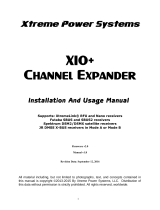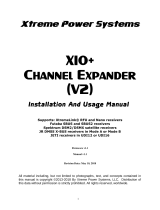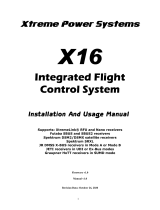Page is loading ...

O
RANGE
RX
DSMX/DSM2/D
EVO
2.4GH
Z
A
UTO
T
RANSMITTER
M
ODULE
(F
UTABA
C
OMPATIBLE
)
U
SER
M
ANUAL
F
EATURES
:
• Works with any Futaba compatible module-based transmitter
• 4 modes: DSM2 1024/22ms, DSM2 2048/11ms, DSMX 22ms, DSMX 11ms.
• Power output - 70mW
• Easy to access bind button
• Range check mode (1mW)
• Current consumption: 100mA
C
OMPATIBILITY
:
Standard Futaba 5 pin module-based transmitters (Futaba compatible)
2.4Ghz protocol: DSMX / DSM2
Input Voltage: 6 - 18VDC
Power: - 70mW
Radio Type: Full range system
O
UTPUT PROTOCOLS
:
DSM2 –1024/22ms, 2048/11ms
DSMx – 22ms/11ms
T
X MODULE
I
NSTALLATION
The Tx module can be installed and used in following radio transmitters:
- All Futaba compatible radios with external Tx module compartment
A
NTENNA
P
OLARIZATION AND ORIENTATION
For optimum RF link performance it’s important that the antenna be oriented in the way
that allows for the best possible signal reception when the aircraft is in all possible attitudes and
positions. Follow simple rules:
- Never point antenna to the aircraft. Pointing antenna to the aircraft will give you the worst reception.
- Don’t block an antenna with metal objects (frames, trays, monitor and smartphone holders). This weakens the signal.
- In the most situations it is better to position antenna horizontally to get better performance and avoid pointing antenna to the aircraft.
ID
CHANGE
To make sure that many models can be controlled at the same time and place without interference to each other a unique ID is assigned to
each control communication. A transmitter module provides this ID to the receiver during binding procedure. There is totally more than 4 billion
combinations available. You may want to change ID before binding to another model to make sure that if you accidently turned previous model
ON with settings for the new model, the previous one will not respond to your radio transmitter.

R
ANGE
T
ESTING
Before each flying session and especially with a new model, it is important to perform a range check.
Make sure that your transmitter battery is fully charged. Be careful and make sure that all propellers on your aircraft are removed.
Turn your transmitter on and following turn on your receiver.
Make sure that the orange LED on your receiver/satellites is ON and solid. That indicates a good signal received.
Move the sticks and confirm that all servos/control surfaces are moving smooth and without stopping and delays. Ask your buddy to watch your
aircraft.
Move 30 steps away (appr. 28 meters). Press and hold BIND button. Move sticks and check if all servos are moving smooth and without
delays. Check if orange LED on the receiver is solid ON.
If orange LED is solid ON and all control surfaces move smooth and no delays then the range test is PASSED.
C
ONNECTORS
:
Connector P1 Pin description:
PIN1- PPM signal, TTL 5V, 6-12 channels
PIN2- VCC In, 6-18VDC, 100mA
PIN3- for future use,
PIN4- GND
PIN5- Not connected
Antenna connector:
SMA connector to attach a standard rubber duck 2.4GHz 50Ohm antenna.
B
UTTONS
:
Button 1(ID)
When pressed upon power on a new unique ID is assigned to Tx.
There is totally 4 billion combinations available. When powered up with Button1 pressed the new ID will be generated. The procedure
of new ID generation is initiated regardless if PPM signal present or not. After detection of Button 1 pressed module waits for 3 sec
then generated a new ID and buzzer generates long beep (0.3 sec). After this the module waits until the button 1 is released. When
button is released the module detects PPM signal from the radio.
Button 2(Bind)
When the module is powered on while the button is pressed a binding procedure is initiated.
When pressed during operation the output power is reduced to 1mW for a range check
During binding procedure the output power is fixed at 0.006mW
During Range test procedure the output power is fixed at 1mW.
LED
FUNCTIONALITY
:
During normal working operation LED indicates current working mode.
DSM2, 1024 mode – OFF
DSM2, 2048 mode – single blinks
DSMx, 22ms mode – double blinks
DSMx, 11ms mode – triple blinks
B
UZZER
:
Buzzer indicates the status and the mode of the Tx module. When it is powered ON in presence of PPM signal (normal operation) you should
hear three short beeps. If you powered your radio and don’t hear three short beeps that means your radio probably doesn’t output the PPM
signal. The reasons for the radio not outputting PPM signal can be:
- Your radio is not set up to output PPM signal;
- Sticks, and/or switches are not in their initial position – throttle might be high or switches for landing gear/flaps/throttle hold are not in
proper position. Check your switches and sticks position.
During binding procedure upon successful binding the module will also make three short beeps. With unsuccessful binding it will be a
single long beep.
O
PERATING MODES
:
LED and Buzzer:
Button1 – ID change
Button2 – When pressed during operation the output power is reduced to 1mW for a range check. When pressed during
power on a binding procedure will be initiated
Buzzer – – beeps 3 times on power ON after detecting PPM on the PPM input
LED – DSM2, 1024 mode – OFF
DSM2, 2048 mode – single blinks
DSMx, 22ms mode – double blinks
DSMx, 11ms mode – triple blinks
Functionality:

Power ON:
When powered up the module is waiting for valid PPM signal to be detected.
As soon as PPM signal is detected the buzzer generates three short beeps (0.1s) indicating that the system is ready.
When module starts transmitting RF packets red LED is will blink according to the mode selected during binding (!).
For example if your receiver supports only DSM2, 2048ms and it is bound to the Tx module in this mode, Tx module will
produce single blinks during the normal operation.
Binding procedure:
After power ON with the Button2 detected pressed and valid PPM signal present the module generates three sort beeps and
enters binding procedure.
The module sets output power at 0.006mW and starts binding procedure. Based on your receiver capability one of
following modes will be selected:
DSM2, 1024 mode
DSM2, 2048 mode
DSMx, 22ms mode
DSMx, 11ms mode
After that the module generates three short beeps. If the bind was unsuccessful it generates one long beep. After binding
procedure is over the module enters the regular transmitting mode and stays in this mode until power turned off.
The settings for transmission will not be changed if the binding procedure was unsuccessful. If the binding procedure was
successful the settings will be changed to the new ones.
If the receiver and the module can operate with different protocols following priority is taken (from most simple to most
advanced):
DSM2->DSMx
1024->2048
22ms->11ms
ID change:
When powered up with Button1 pressed the new ID will be generated. The procedure of new ID generation is initiated
regardless if PPM signal present or not. After detection of Button 1 pressed module waits for 3 sec then generated a new ID
and buzzer generates long beep(0.3 sec). After this the module waits until the button 1 is released. When button is released
the module detects PPM signal from the radio. Following binding procedure is necessary.
/



